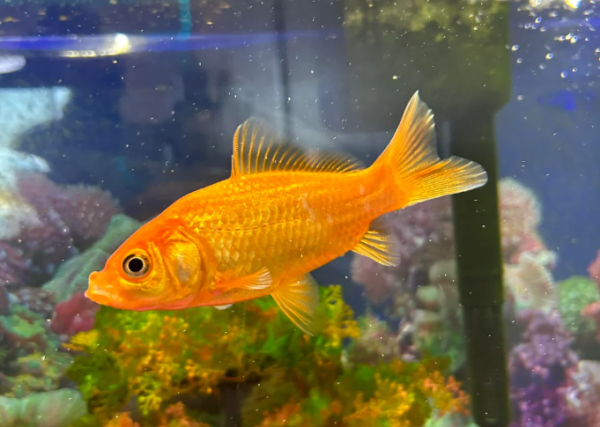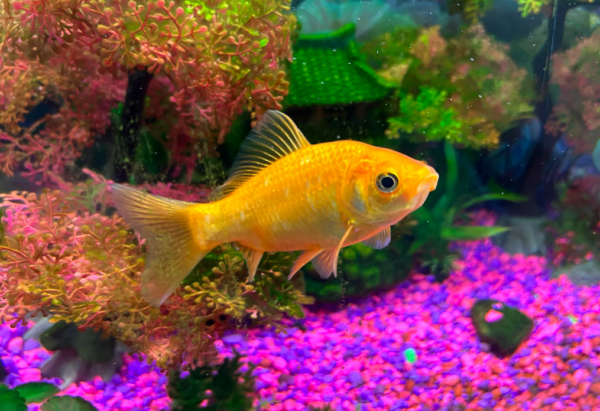Aggressively bred to become increasingly vibrant, goldfish are one of the most prevalent freshwater fish in the aquarium trade. They belong to the carp family and some of the species can grow up to 2 feet. However, most fancy goldfish that you may find in pet stores, are modified to be limited to a few inches.
Officially, more than 125 basic varieties of goldfish featuring a wide range of colors, including orange, red, black, yellow, white, and purple, are found in aquariums. Yet, the number seems like lowballing when we include varieties with unique bodily features like head bumps and protruding eyes.
Goldfish are omnivorous creatures with a friendly demeanor towards their tank mates and caregivers. Despite their small brain and questionable memory, goldfish are capable of identifying us and our small gestures, especially when it comes to feeding.
And feeding leads us to today’s topic:
Table of Contents
Do Goldfish Have Teeth?
The short answer is yes, goldfish do have teeth. But, their teeth are quite different from what we see on sharks and other predatory fish. A small set of flat, benign teeth, positioned deep inside their throat, are present in goldfish. They aren’t designed to rip, cut, or bite flesh.
These types of teeth are called pharyngeal teeth and are mostly found in cyprinids (like carps), suckers (like plecos), and other species that otherwise lack prominent teeth. Flat teeth are particularly useful for goldfish as they’re mainly gulpers. They eat their food whole and grind it into smaller bits with the help of these teeth before passing it down to the digestive system.
Also Read: Black Moor Goldfish Care Guide: Breeding, Disease, Diet
Where Goldfish Have Their Teeth?
Your goldfish’s teeth aren’t located in its mouth but rather in the pharynx, hence the name. The pharynx is a muscular chamber at the back of the throat, located mainly where the gill ends. The small teeth are arranged in rows on pharyngeal arches, which support the gills and the pharyngeal teeth.
Slightly varying between different varieties, goldfish teeth are tiny, numerous, and comprise multiple rows. Often, the teeth lack uniformity and are supplemented by a consistent supply of new fixtures. The diet also contributes to the shape of the teeth. Herbivorous goldfish have much broader and flatter molar-like teeth, whereas omnivorous goldfish varieties have relatively sharper, more pointed teeth.
Can Goldfish Bite You and Does Goldfish Bites Hurt?
Fish with traditional teeth settings are made to crush hard shells and bite flesh with their powerful jaws. Goldfish teeth aren’t exactly built for that. While your goldfish may playfully nibble on your fingers, they lack the strength and intent to crush your fingers with their teeth unless you have a huge goldfish with enough space inside its mouth for your fingers.
Goldfish nibbles also are pretty benign and the worst they can do is tickle. However, avoid hand-feeding and putting your fingers directly in the tank if you don’t wish to be subjected to the harmless behavior.
Also Read: 20 Fun Facts About Goldfish – 13th One Is The Most Interesting
Can Goldfish Eat Other Fish?
While it’s against their nature, goldfish can eat smaller fish, shrimp, and fish larvae. Goldfish teeth are strong enough to grip and grind them. But, as goldfish are sloppy swimmers and smaller fish can easily move away, it’s unlikely to happen.
However, frankly, most fish feed on fish eggs and larvae if left unprotected.
What Happens When Goldfish Teeth Falls Off?
As a goldfish keeper, you may already have noticed tiny, white alien pellets lying around the tank. This becomes more apparent if you have a dark sandy substrate present.
These are the fallen-off teeth of your goldfish. Throughout your goldfish’s life, it’ll lose and regrow the pharyngeal teeth multiple times. A reserve set of teeth always exists beneath their gums, ready to emerge when the old sets fall off.
Also Read: Oranda Goldfish: Complete Guide To Care, Breeding, Tank Size And Disease
Other Interesting Fish With Teeth
While goldfish have many interesting traits, their set of nonmalignant teeth is not among them. Here are a few fish with teeth that may garner your curiosity:
1. Piranha
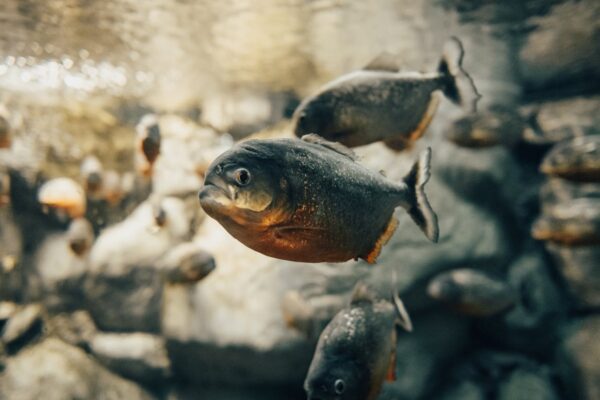
Originating 10 million years ago, Piranhas, among their other family members, inhabit mainly the freshwater lakes, rivers, and floodplains of the Amazon River basin. While they have a reputation for preying on large prey, Piranhas mostly are opportunistic feeders and rely on dead animals, insects, small fish, and fruits.
Piranhas have sharp, triangular interlocking teeth in both their jaws. These teeth are serrated like knives to tear flesh with ease. Their jaws also can exert a surprising amount of force for their size, which is often used to take small bites and crack the hard shells of fruits. However, their teeth are small and are usually hidden behind their big lips.
2. Sharks
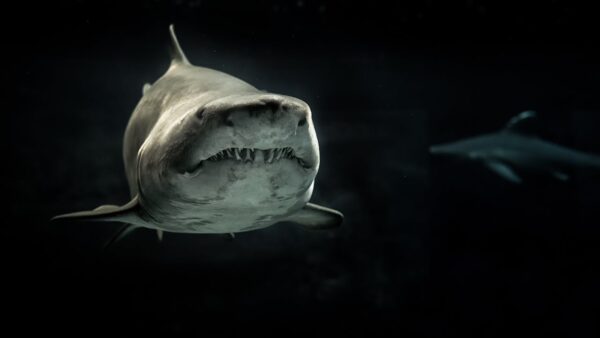
Mostly inhabiting the world’s oceans from warm tropics to chilly arctics, sharks have been around for an incredibly long time. It’s estimated that they have been navigating the oceans for 400 million years, predating the dinosaurs. However, as sharks are made of cartilage, their fossils aren’t easy to find. But, fossilized shark teeth have been found in many locations around the world.
Depending on the shark species, their prey varies. But, most of them regularly feed on fish, squid, seals, sea lions, and even plankton. In relationship to their feeding habits, species-wise teeth variations also are present. This is where it gets interesting, most shark species have several rows of back-facing razor-sharp teeth that hold onto their prey and bite them off clean. Sharks lose thousands of teeth and regrow them constantly throughout their lives.
3. Pufferfish
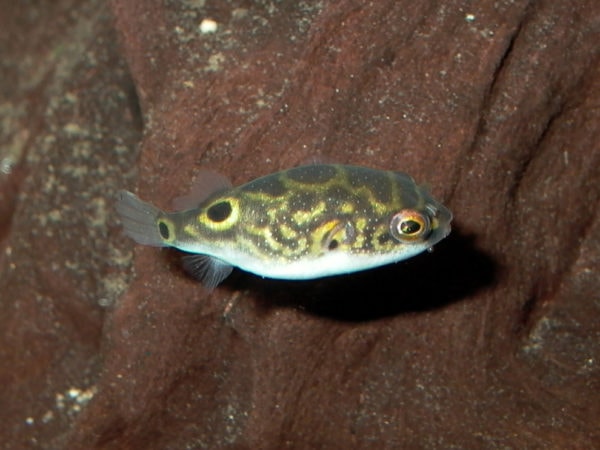
Pufferfish, also known as puffers or blowfish, originated in the Indo-Pacific region 40 million years ago. They have since spread to tropical and sub-tropical waters around the world. Puffers prefer warm waters and usually inhabit coral reefs, estuaries, mangroves, and freshwater lakes. They also love places with lots of hiding space, like rocks, crevices, and seaweed beds.
Pufferfish rely on an omnivorous diet but prefer crabs, shrimps, snails, and worms. Their strong teeth also are specifically designed to crack the hard shells of crustaceans and crush hard-bodied prey. Puffers have four fused teeth, in sets of twos in both upper and lower jaws. Interestingly, their teeth don’t get replaced but grow constantly, making them gnaw on hard objects to prevent them from overgrowing.
Also Read: Dwarf Pufferfish: The Ultimate Care Guide
4. Triggerfish
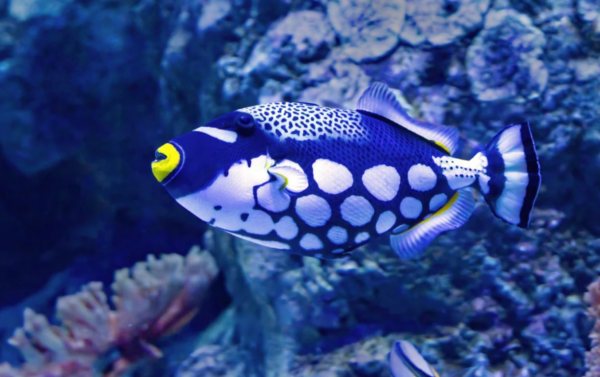
Preferring warm, tropical, and subtropical water, Triggerfish are believed to have originated around 50 million years ago during the Eocene epoch. They still are pretty widespread in shallow, coastal areas, particularly in coral reefs. An exception is the Oceanic Triggerfish, that roam the open ocean. Most members of the Triggerfish family are opportunistic feeders and love feeding on sea urchins, mollusks, crabs, and corals.
Their specifically designed teeth comprise two sets of four sharp teeth on each side of the jaw and an extra set of six pharyngeal teeth on the upper jaw. The sharp teeth allow Triggerfish to crush the hard exoskeletons of their prey and the pharyngeal teeth allow them to grind their flesh. Each of these teeth constantly gets replaced multiple times throughout their lives.
5. Flathead Catfish
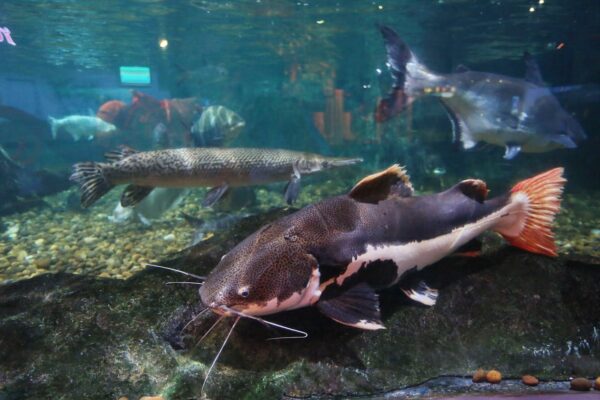
Predatory and invasive flathead catfish are native to North American lake regions and northern Mexico, but they have now been introduced in many waterways around the water. Slow-moving rivers and reservoirs with plenty of structures and sunken logs are preferred by this intriguing fish, even though they get accustomed to almost any freshwater environment. Flathead catfish are apex predators who rely on hiding and ambushing their prey during the night.
Despite popular beliefs, flathead catfish don’t actually have teeth. They have multiple bony plates in their jaws to hold and crush their prey. They also have powerful suction to swallow their food whole. However, a bite from flathead catfish can hurt a lot, thanks to their powerful jaws and toxic skin.
Also Read: Fancy Goldfish: Care Guide, Breeding, Tank Size, & Disease
FAQs
No, goldfish bites don’t hurt, as they can’t theoretically bite you with their pharyngeal teeth. They only nibble on your hand as a display of playfulness and beg for food.
Yes, all goldfish species have teeth. But, they’re well hidden behind their throat and around their neck region. They aren’t meant to hurt you, and in most cases, your fingers can’t reach them. However, that doesn’t mean that your goldfish can’t eat shrimp and other live food.
All species of fish have unique types of teeth. The different types of teeth include:
– Canonical teeth (Small pointed teeth)
– Villiform teeth (brush-like teeth)
– Canine teeth (Long pointed teeth
– Incisor teeth (Chisel-shaped teeth)
– Molariform teeth (Broad, flat teeth)
– Pharyngeal teeth (Teeth in pharyngeal bones)
The Bottom Line
We’ve covered most questions that you may have regarding your goldfish’s teeth and whether they can bite and gnaw your fingers off. Thankfully, they can’t. You’ll be able to learn all about goldfish teeth and other types of fish teeth from our comprehensive article. All the best!

